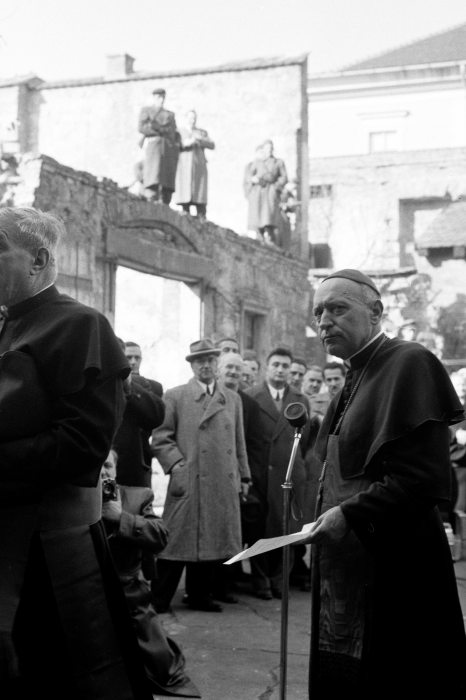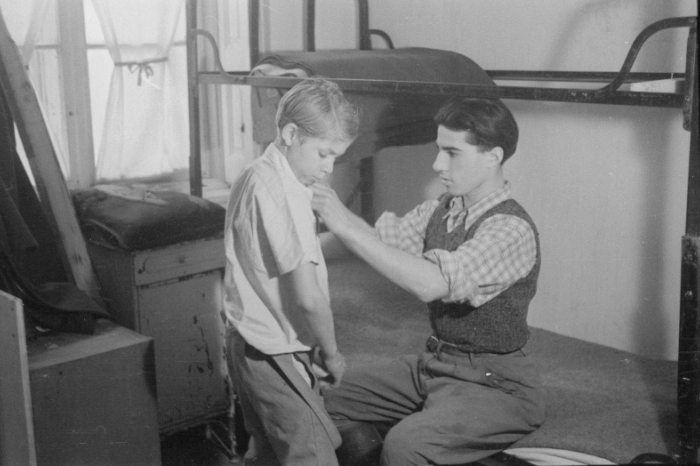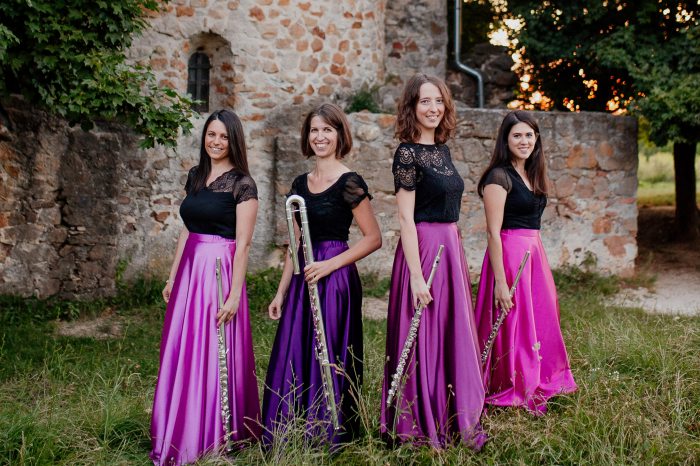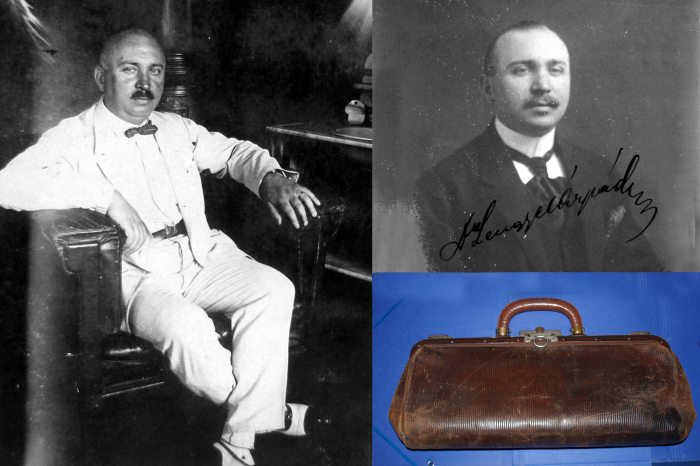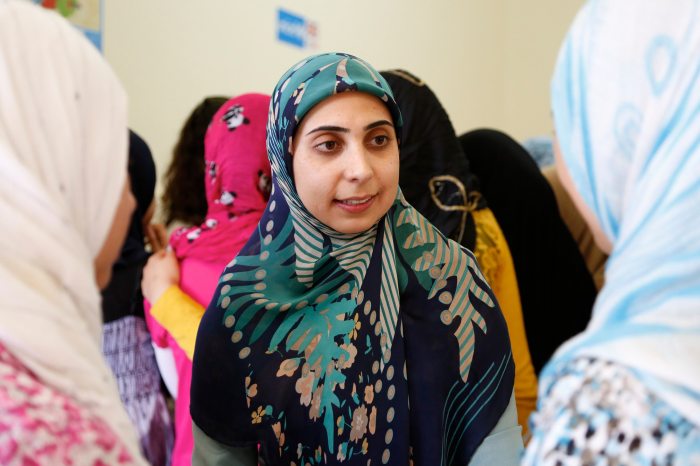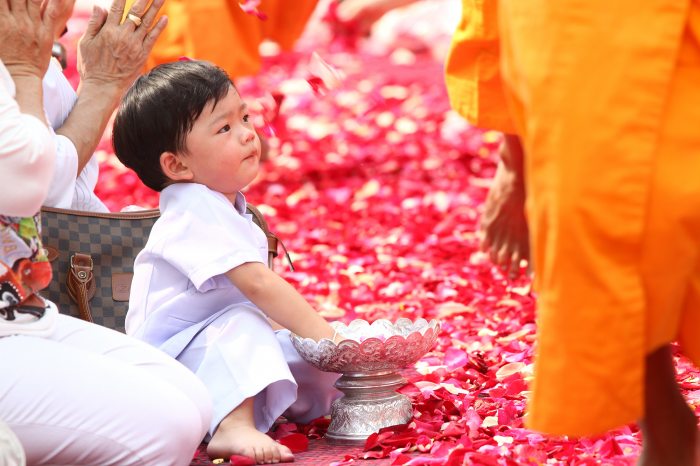Most societies from ancient times sourced the flute directly from the gods due to its wondrous tone. However, as an amateur I presume that the flute is far from simply to play. What sort of technical challenges face someone who chooses this instrument?
Eszter Gedai: “The lips, which channel the air towards the barrel, are highly sensitive and they must be used both delicately and steadily. In addition, we try to perfect the breathing technique, exploiting the full capacity of the lungs. In fact, it calls for the coordinated functioning of the entire body so that while playing the flute we do not even see the parts of the body that are most important to generating the sound.”
Kinga Kovács: “Despite the fact that four flutes playing together harmonize extremely well, far fewer works have been written for this instrumental combination than, for example, the string quartet. One of the reasons for this is that alto and bass flutes, which we also use in our quartet, were only developed in the 20th century.”
What motivated you to establish the Flautett Flute Quartet?
Júlia Ernyey-Balogh: “Our story began in the Varga Tibor Institute of Music of the Széchenyi István University, Győr, where we all studied. In fact, the idea of playing music in a quartet came from our teacher and mentor, flautist Gergely Ittzés, because one of the most joyful parts of building up credits at the university is the compulsory chamber class. Kinga, Zsófi and Anna Szarvas joined me and together we formed a flute quartet. Our first major appearance was at my diploma concert.”
Kinga Kovács: “In the course of rehearsals, we realized we worked very well as a team and then the idea arose that it would be great to play music together in the future, thus out of the ‘compulsory’ came a fantastic opportunity.”
Eszter Gedai: “Next, I took over Anna’s place in 2015. The friendship and working relationship has continued, Anna remains a welcome guest to this day.”
Zsófia Réman: “Right from the beginning, Gergely Ittzés said how unusual it was that our flute sound should come together with such clarity in such a short time – this gave us a huge confidence boost. Since then it has been our goal to play music to a high standard and get our music out to as wide an audience as possible. We love collaborating with other musicians, composers and representatives of different branches of the arts.
“Our repertoire is becoming increasingly diverse: from Baroque music to contemporary works, we enjoy playing in all styles, not only works written for four flutes but arrangements as well.”
Did you dream of a career in music even as children?
Zsófia Réman: “It was natural for me to be surrounded by melodies because my parents and my sibling are musicians, we could make up a compact orchestra together with other music-playing members of our wider family. In effect I grew up in the orchestral embrace of the Cluj-Napoca Hungarian Opera, so I was most attracted to this world right from when I was very young. I remember we had a jazz CD of flute and piano pieces, I listened to it a thousand times and I was determined that one day I, too, would play the flute. My path started from the Cluj-Napoca conservatory, then after studying in Győr, Budapest and Düsseldorf I saw my dream come true: at the moment, as well as playing with Flautett, I am flautist with the Dohnányi Orchestra Budafok.”
Kinga Kovács: “I, too, come from a musical family, my father is a teacher of the flute. It was clear that I wanted to be a musician, I was captivated by everything that is music. I am a teacher of flute at the Budaörs Leopold Mozart School of Music, and as a teacher of the Alexander technique I am a member of the Society of Teachers of the Alexander Technique in Budapest. These two things complement each other perfectly. My progress with the flute was not without its difficulties, I often felt that despite my best intentions, I wasn’t able to achieve what I wanted to on the instrument. My muscles were all tensed up but I didn't even realize this. That’s when I started practicing the Alexander technique, then learning and finally teaching it. The technique helps in attaining body awareness and a healthy posture, it eases cramps caused by stress and helps in developing a better mood. The girls also use it.”
Flautett Flute Quartet - Photo: Ágnes Szűcs
Eszter Gedai: “My father is a solfege teacher, my brother is an organist. Even as a music school student, I was keenly interested in chamber music and for several years I played in a flute quartet made up of music school students. I entered competitions and attended master classes, in 2016 I studied with a scholarship at Leuven in Belgium, and I continued my harpsichord studies. I teach flute at the Rácz Aladár Elementary School of Art in Budapest’s XVI district.”
Júlia Ernyey-Balogh:
“I’m the odd one out because nobody in my family was a musician and I didn’t make up my mind to be a flautist as a child.
“I come from a family of five children, we all learned one instrument or another, my parents passed on their love of music, we sang a lot and played chamber music together. One of my sisters also decided to pursue a career in music and the whole family currently sings in a choir, grandchildren as well. Choral singing is especially important to me, the 12 years I spent attending the Kodály Zoltán Hungarian Choir School were not wasted. To be honest, being a flautist was not a childhood dream of mine, but music became increasingly engrained in my life. Alongside flute studies I also graduated from the conservatory harp department and I was already a flute teacher when I passed my exam in the development of musical abilities, more commonly known as the Kovács method, at ELTE university. At the moment I am at home with my two toddlers and I train guide dogs, too. We also have two ‘professional’ dogs, Szálka is a therapy dog and Perec is a learner disabled helper.”
Where do you rehearse?
Zsófia Réman: “To start with, the base was in Kispest, at Juli’s place, then Juli married and they moved close to the Southern Railway Station so Flautett ‘moved’ there, too.”
Kinga Kovács: “What’s more, the flat next to Juli became vacant so I moved in as a neighbour, then when I moved out of there Zsófi took my place. Since then the residents have been careful to ensure that no other flat becomes available for rent in the house (laughs), but actually we have been very lucky because this apartment block enjoys flute music.”
You’ve had appearances at very many festivals: Valley of Arts, Budapest Spring Festival, Tiberius International Chamber Music Festival, Ars Sacra Festival… You have played together with such outstanding soloists as Gergely Ittzés, István Matuz, Dávid Kanyó, Endre Hegedűs. But what was your most memorable concert?
Zsófia Réman: “Our seventh birthday concert left a deep impression on me, it was a fine summation of our career thus far.
“We performed in front of a full house, our family, friends and mentors were all there, we invited guest artists, there was a quiz, reception, a cake and screening of the most memorable moments from previous years.”
Kinga Kovács: “We’ve also had concerts that became memorable because of a scare. For example, when just before taking to the stage we realized that two entire parts were missing from each score. We had left a folder at the Ars Sacra Festival the previous day… I’ll never forget Juli and Zsófi’s faces when they noticed this and told us.”
Júlia Ernyey-Balogh: “I was proud of us because we were able to react to the situation rapidly, we rearranged the programme in just a few minutes, we performed very collectedly and the audience affirmed this in their applause. In my mind, this proved that we really are a well-functioning, cohesive team.”
Flautett Flute Quartet - Photo: Ágnes Szűcs
Eszter Gedai: “I reckon we can also be proud of our concert in BMC, when we performed exclusively contemporary works. It was a bold undertaking due to the need to master a variety of unusual musical languages. Two works had been written specifically for our quartet and we had collaborated with the masters of most of the pieces, that is with Barnabás Dukay, Endre Olsvay, Bánk Sáry, Péter Tornyai, Ákos Nagy, Árpád Könczei, and Pál Rózsa. On top of this, nearly all these people were sitting there in the auditorium.”
Are you also bound by friendship?
Zsófia Réman: “Of course!
“We are friends first, and only after this a quartet.
“The life of an ensemble might be simpler if there is merely a professional relationship between the members, yet I still believe that an intensive bond of friendship can give far more in human terms. Whereas there is a leader, a principal personality, in the majority of ensembles, with us everyone is of equal rank.”
Eszter Gedai: “We resemble each other in so many ways, we can easily handle our differences, indeed, we often manage to work them to our advantage: we exploit them in the allocation of parts and in the organization of our programmes. It is important that we think alike on the fundamental questions of life. Our notions on tonality and musical formation are very similar because we studied in the same institution and from the same teachers.”
As well as the Alexander technique, is there anything else that helps you overcome the excitement and stress resulting from appearing in public?
Kinga Kovács: “Yes.
“It is very reassuring when, before taking to the stage, we hold each other’s hands and pray together.
“There are times when in the mad rush this lasts just a second or two, but this spiritual bonding is the source of great strength.”
Do you also listen to light music?
Zsófia Réman: “Yes, for example I really love jazz. I don’t listen to classical music for relaxation because despite myself I begin to attend to it with a professional ear.”
Eszter Gedai: “I love listening to world music and folk music.”
Júlia Ernyey-Balogh: “I believe that we are able to provide a full experience on the stage when we are open to different musical genres.”
The quartet celebrates their tenth anniversary on 21 November. How are you preparing for this occasion?
Eszter Gedai: On the one hand, we will be releasing a CD shortly, we are in post-production at the moment. On the other hand, we plan a lovely jubilee concert. The programme is still being worked out, we are preparing several versions, an online concert as well given the unpredictability sparked by the epidemic.”
Kinga Kovács: “According to plans – and if everything really does work out in line with the best-case scenario – we will also appear with our teacher and master, Anett Jóföldi, who is flautist at the Budapest Festival Orchestra, Anna Szarvas, former member of Flautett, and Gergely Bíró, first percussionist with the Hungarian National Philharmonic, who by the way is an international diploma trainer in the Alexander technique. All four of us have had Alexander classes with him. And, of course, we will also welcome our friend, singer Zsófia Staszny, a regular guest at our concerts.”
What advice would you give to people who have never attended a classical music concert? How would you convince them that it is worth taking the time to go to a flute quartet concert, for example?
Eszter Gedai: “First of all, by not assuming too much from the name [Translator’s note: in Hungarian, komolyzene, translated as ‘classical music’, literally means ‘serious music’] because this can be off-putting to many. This is precisely why I prefer to use the term classical music [klasszikus zene].
“The title of one of our earlier concerts was ‘Seriousness Taken Lightly’, thereby signalling that grace, mischief, humour are often apparent in classical music.”
Júlia Ernyey-Balogh: “We always try to put together our programmes so that everyone will discover in them what is closest to their heart and taste. In the wake of a hefty, three-movement work, for example, we love performing a lighter, more playful piece.”
Kinga Kovács: “And there are pieces in our repertoire designed to touch the depths of the listener’s soul. Each piece enriches everyone differently, depending on the personality and current state of mind of the recipient.”
Many consider music to be a tool of communication, while others are of the view that it is a balm resolving differences of opinion between people, then there are those who look on music as a kind of bridge between people of different religious and political outlooks. What does music mean to you?
Júlia Ernyey-Balogh: “Playing chamber music is the greatest ‘team building exercise’.”
Eszter Gedai: “Shared joy. An opening towards the other person, but into oneself as well.”
Kinga Kovács: “It is something we can use to express our emotions, thoughts, state of mind.”
Zsófia Réman: “It is like pearl fishing: we submerge ourselves in musical compositions, we seek within them the pearls, then we rise to the surface in order to reveal them to the audience.”


